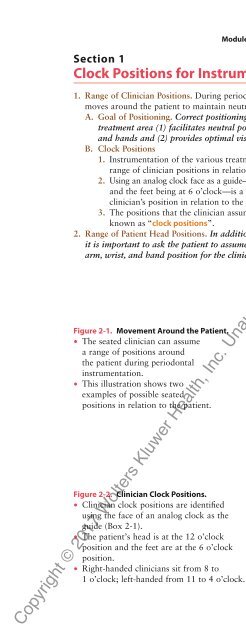Unauthorized
OE0W300oZ7I
OE0W300oZ7I
Create successful ePaper yourself
Turn your PDF publications into a flip-book with our unique Google optimized e-Paper software.
Section 1<br />
Clock Positions for Instrumentation<br />
Module 2 Clinician Position in Relation to the Treatment Area 41<br />
1. Range of Clinician Positions. During periodontal instrumentation the seated clinician<br />
moves around the patient to maintain neutral body posture.<br />
A. Goal of Positioning. Correct positioning of the seated clinician in relation to the<br />
treatment area (1) facilitates neutral posture of the clinician’s head, arms, wrists,<br />
and hands and (2) provides optimal vision of the tooth surfaces.<br />
B. Clock Positions<br />
1. Instrumentation of the various treatment areas may be accomplished from a<br />
range of clinician positions in relation to the patient’s head (Fig. 2-1).<br />
2. Using an analog clock face as a guide—with the patient’s head being at 12 o’clock<br />
and the feet being at 6 o’clock—is a common method of identifying the<br />
clinician’s position in relation to the patient (Fig. 2-2).<br />
3. The positions that the clinician assumes in relation to the patient’s head are<br />
known as “clock positions”.<br />
2. Range of Patient Head Positions. In addition to assuming an optimal clock position,<br />
it is important to ask the patient to assume a head position that facilitates neutral<br />
arm, wrist, and hand position for the clinician (Fig. 2-3).<br />
Figure 2-1. Movement Around the Patient.<br />
• The seated clinician can assume<br />
a range of positions around<br />
the patient during periodontal<br />
instrumentation.<br />
• This illustration shows two<br />
examples of possible seated<br />
positions in relation to the patient.<br />
Figure 2-2. Clinician Clock Positions.<br />
• Clinician clock positions are identified<br />
using the face of an analog clock as the<br />
guide (Box 2-1).<br />
• The patient’s head is at the 12 o’clock<br />
position and the feet are at the 6 o’clock<br />
position.<br />
• Right-handed clinicians sit from 8 to<br />
1 o’clock; left-handed from 11 to 4 o’clock.<br />
Copyright © 2017 Wolters Kluwer Health, Inc. <strong>Unauthorized</strong> reproduction of this content is prohibited.<br />
9<br />
10<br />
8<br />
11<br />
12<br />
1<br />
4<br />
2<br />
3<br />
LWBK1504-C02_p039-068.indd 41<br />
1/14/16 5:48 PM


